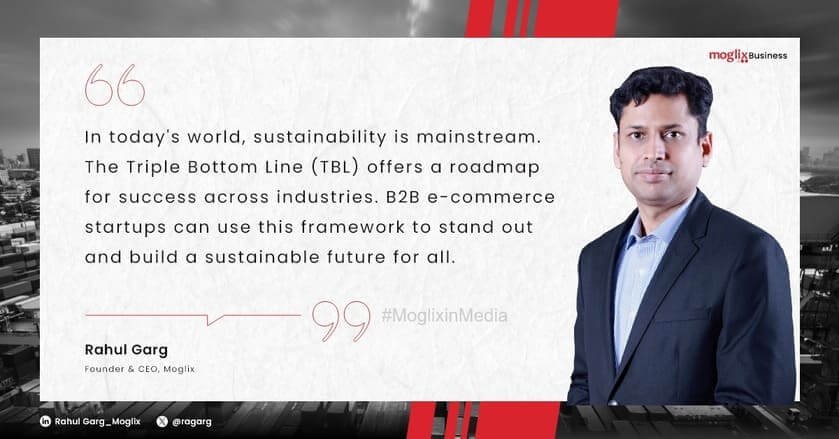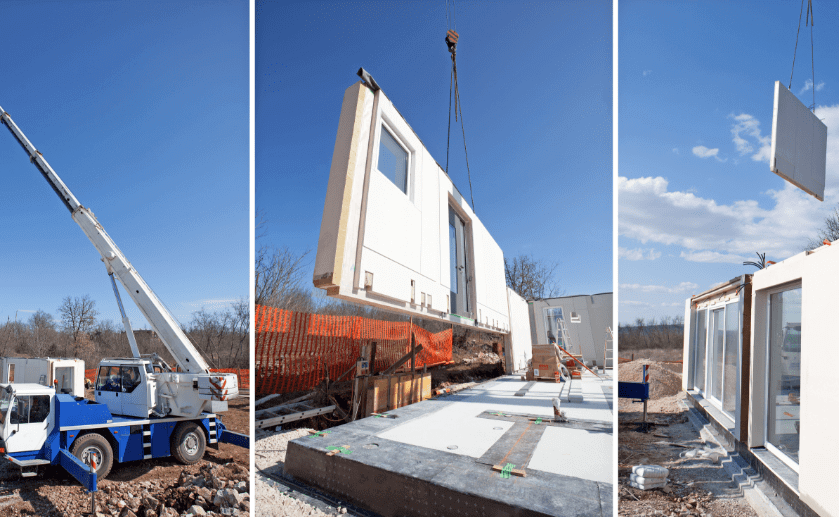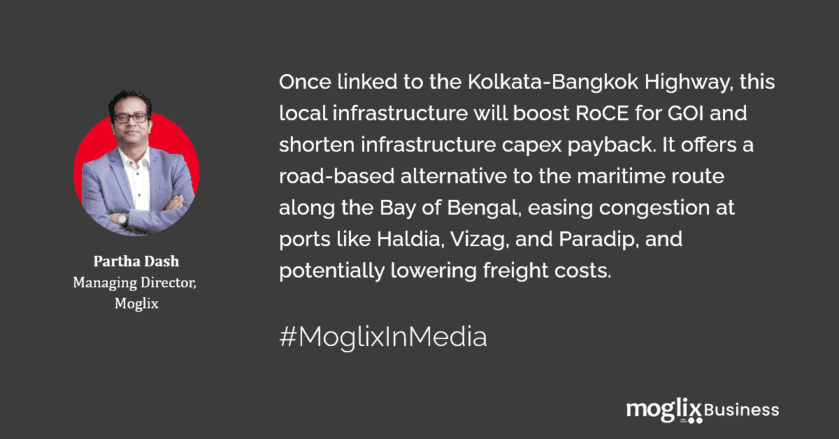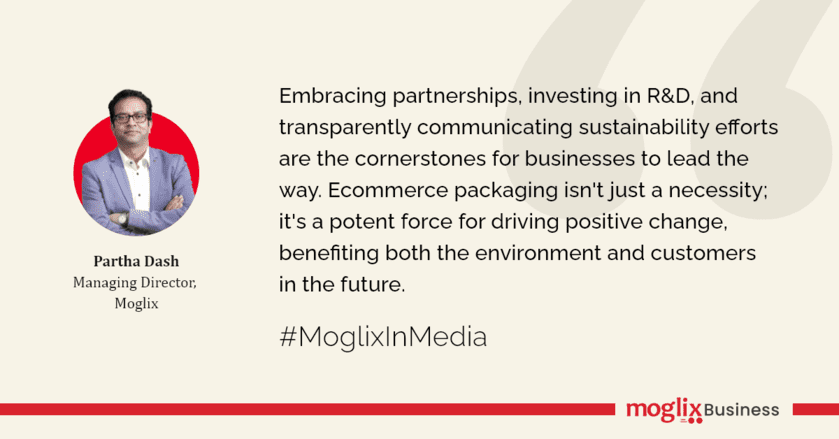Sustainable Success: The B2B E-commerce Trinity of People, Planet, and Profit

Sustainable Success: The B2B E-commerce Trinity of People, Planet, and Profit
Since the inception of balance sheets, the ‘bottom line’ has served as the ultimate conclusion for businesses—a singular metric, focus, and story. Yet, the narrative is evolving. Today’s businesses are acknowledging the limitations of this singular approach and embracing a more comprehensive one: the Triple Bottom Line (TBL). This framework acknowledges that a company’s success extends beyond financial performance to encompass its impact on both people and the planet. With over 80% of the largest 100 companies adopting this approach, they have witnessed their average annual ROI soar to 13.5%, surpassing the traditional business average of 9.1%.
Read MoreHow CEOs of EPC Project Developers Can Improve EBITDA Through Use of Prefabricated Structures?

How CEOs of EPC Project Developers Can Improve EBITDA Through Use of Prefabricated Structures?
Can adopting prefabrication enhance the EBITDA for the EPC sector?
The answer is Yes. These days EPC project developers are already harnessing the benefits of Prefabrication.
In fact, in China, a famous construction company erected a structure in just 5 days. When research was conducted on the construction analysis, it revealed that prefabrication reduces construction timelines—by up to 36.04% for timber frameworks and 25.53% for masonry activities.
This evidence really makes it clear why firms should start leaning into prefabrication—it’s all about getting better results, both financially and operationally.
Let’s dive into how you can make that happen in this blog.
Boosting EBITDA with Prefabrication: A Strategic Shift for EPC Leaders
Think about it: prefabricated structures are quickly becoming the go-to for fast-tracking projects like schools, hospitals, and homes. And for the CEOs of EPC Project Developers, there’s a golden opportunity here to boost your EBITDA.
Enhanced Project Scheduling and Planning
Incorporating prefabricated structures into the infrastructure supply chain emerges as a strategic maneuver for CEOs of EPC Project Developers aiming to boost EBITDA, underscored by the tangible predictability enhancements it brings.
A pivotal productivity indicator, the project schedule, sees a notable uplift from prefabrication/modularization techniques.
According to feedback from industry stakeholders, 66% of respondents attest to a positive influence on project timelines due to Prefabrication, with 35% of them reporting schedule reductions of four weeks or more. A prime example of this is the assembly of the CitizenM Hotel in New York City using 210 prefabricated modules within 19 days, underscoring the profound efficiency and time-saving potential of prefabricated structures in meeting tight project deadlines and accelerating market readiness.
Improved Cost optimization
EPC CPOs aiming to boost EBITDA find a valuable ally in prefabricated structures, known for slashing project costs. According to Dodge Data and Analytics, 65% of over 800 AEC professionals surveyed report budget reductions, with 41% noting cuts of 6% or more. EVgo’s venture into prefabricated DC fast chargers, reducing installation times by 50% and costs by 15%, exemplifies this efficiency.
This approach acts as a strategic tool for financial and operational optimization in EPC ventures.
Risk Mitigation
Adopting Prefabrication offers CPOs a strategic path to enhance EBITDA through improved safety, a critical concern in the construction industry.
According to McGraw-Hill Construction, 34% of users report enhanced site safety with prefabrication, attributing this to fewer needs for high-risk activities like scaffolding work and minimizing tight-space operations.
Notably, CPOs, especially those in EPC firms, observe the most significant safety improvements, aligning risk management with financial optimization, thereby indirectly boosting EBITDA through reduced accidents and associated costs.
End Game: The Impact of Adopting Prefabricated Structures on EBITDA of EPC Project Developers
Prefabrication and modularization represent key strategies for EPC CPOs aiming to enhance EBITDA, offering benefits in efficiency, cost reduction, and site safety. As these construction methodologies gain traction, they are pivotal for competitive advantage and financial success.
For in-depth insights and implementation strategies, Moglix Business provides expert consultation. With a solid history in significant EPC projects and a comprehensive design-build-delivery framework, Moglix Business is a valuable resource for EPC professionals looking to optimise project outcomes through Prefabrication. Explore more to discover how you can transform your project delivery and achieve unparalleled success with Moglix Business custom fabrication solutions.
How Progressive Design-Build Can Enable CEOs of EPC Project Developers to Reduce Time and Cost Overruns

How Progressive Design-Build Can Enable CEOs of EPC Project Developers to Reduce Time and Cost Overruns
How can the persistent issue of project overruns be addressed by CEOs of EPC project developers?
A revealing case study from Jordan, where machine learning models were used to predict project cost and time overruns, showed that every project had cost overruns: 76% due to incorrect estimations and 24% due to overstated estimates. This highlights the critical challenge of managing costs and timelines effectively.
Here, Progressive Design-Build emerges as a strategic solution offering a new direction for industry leaders. This blog outlines how the Progressive Design-Build approach can be a game-changer for EPC project developers.
Design-Build: A Strategic Approach for EPC Projects
In EPC projects, the Design-Build is a simple process. The reason behind this is that the combination of the design and construction stages is part of one contract.
This approach brings clarity and eliminates conflicts that are often present in the traditional Design-Bid-Build model.
Cost and Speed Advantages
Design-Build projects present a notable financial advantage, being at least 6% less costly than those using the Design-Bid-Build method and 4.5% less than those managed through Construction Manager methods.
This efficiency translates into direct savings for EPC project developers, underscoring the method’s financial benefits.
Moreover, the speed of construction with Design-Build outpaces traditional methods, being at least 12% faster than Design-Bid-Build and 7% faster than Construction Manager approaches. This acceleration ensures projects are completed within tighter schedules, enhancing overall project efficiency.
Progressive Design-Build: A Comparative Analysis
A comparison between Progressive Design-Build (PDB) and traditional Design-Build (DB) emphasizes PDB’s improved time performance. PDB projects have significantly lower time overruns (0.41% for PDB vs. 8.0% for DB), showcasing the method’s capability to keep projects on schedule. Despite these differences, both PDB and DB effectively manage costs, with no significant variance in cost performance between them.
End-Game for CEOs of EPC Project Developers: Zero Down Time and Cost Overruns
For EPC project developers aiming at efficiency, cost-effectiveness, and timely project completion, the Design-Build method, especially its progressive variant, stands out.
This approach is underpinned by strong statistical evidence showcasing its advantages in cost savings, construction speed, and market adoption.
Moglix Business emerges as a strategic partner in this context, providing customized solutions to meet the unique challenges of infrastructure development. Interested parties who want to learn more about it are encouraged to explore how Moglix Business custom fabrication solutions can elevate their projects to new heights of success and operational efficiency.
AI and automation: Propelling the Future Growth of B2B SaaS

AI and automation: Propelling the Future Growth of B2B SaaS
Artificial Intelligence (AI) is no longer a futuristic concept; it’s a present-day reality. Businesses have moved beyond the question of whether to adopt AI and are now focusing on how to effectively deploy and scale it to maximize benefits. Projections indicate a significant surge in revenues within the AI software industry, expected to reach $120 billion by 2026 from a mere $10 billion in 2018. The manner in which businesses harness these services will profoundly impact their future revenues.
Read MoreWomen are emerging as leaders in the supply chain and operations landscape.

Women are emerging as leaders in the supply chain and operations landscape.
As the global marketplace continues to evolve, our perception of leadership must evolve alongside it. Gender diversity isn’t merely a trend—it’s a crucial strategic necessity. Research consistently demonstrates that teams with diverse backgrounds outperform those lacking diversity, bringing a wealth of perspectives and experiences that drive innovation and resilience.
Within the dynamic realm of supply chains and operations, a silent revolution is taking place. Women, formerly confined to the sidelines, now stand at the forefront, breaking stereotypes and reshaping conventional notions of leadership within this complex network. In this article, we will delve into the significance of empowering women leaders in supply chain and operations. By challenging traditional norms, promoting inclusivity, and embracing diversity and innovation, women leaders play a pivotal role in driving organizational success.
Why CEOs of Hard-to-Abate Industries in India Should Consider Investing in CCUS?

Why CEOs of Hard-to-Abate Industries in India Should Consider Investing in CCUS?
As per the Paris Agreement, all nations worldwide are committed to reducing greenhouse gas (GHG) emissions by 45% by 2030 and reaching net zero by 2050. In this regard, reducing emissions from various industries is a great challenge. This is especially challenging for hard-to-abate industries like steel, cement, and chemicals. These industries are crucial for economic development. Yet, they account for about 30% of the world’s greenhouse gas emissions. The CCUS technology (carbon capture, utilization, and storage) is a possible solution. Let’s understand how CCUS is an ideal investment for Indian CEOs of hard-to-abate industries to tackle GHG emissions effectively.
What is CCUS?
CCUS represents a series of processes to capture CO2 directly from fossil, biomass stations, industries, or air and convert it for various applications. Once captured, the CO2 is transported by ship or pipeline to the point of storage or application. There, it gets processed for various applications. Majorly, it is used for enhanced oil recovery (EOR) or the production of low-carbon fuels like methanol. The same can be used as an input or feedstock to create products or services. Otherwise, the CO2 is securely stored in geological formations so that it does not enter the atmosphere and harm the climate balance. .php?post=24032&action=editCCUS represents a series of processes to capture CO2 directly from fossil, biomass stations, industries, or air and convert it for various applications. Once captured, the CO2 is transported by ship or pipeline to the point of storage or application. There, it gets processed for various applications. Majorly, it is used for enhanced oil recovery (EOR) or the production of low-carbon fuels like methanol. The same can be used as an input or feedstock to create products or services. Otherwise, the CO2 is securely stored in geological formations so that it does not enter the atmosphere and harm the climate balance.
What CCUS Technologies Are Available Today?
Some major CCUS technologies are available today to handle carbon emissions easily. Let’s understand how CO2 is processed under these CCUS technologies.
- Direct Air Capture (DAC): Collected directly from the using air filters
- Carbon Capture at Power Plants: CO2 is captured from power plants and processed for storage or enhanced oil recovery.
- Enhanced Rock Weathering (ERW): Crushed silicate minerals like basalt and glauconite increase the soil’s CO2 capture capacity.
- Aqueous Amine-Based CO2 Capture: Using amines to absorb CO2 for storage or reuse
- Membrane Gas Separation: Using permeable materials to separate carbon dioxide and other gasses at low temperatures and pressures
- Carbon Capture and Conversion: Converting the captured CO2 into usable products such as fuels, industrial chemicals, and polymers.
- Chemical looping: Using metal-based particles to separate CO2 from the fuel for storage and further reuse
- Cryogenic Carbon Capture (CCC): Leveraging cryogenic cooling to capture and remove CO2 from gas streams
- Carbon Capture Using Nanotechnology: Carbon nanotubes capture CO2 at a very low pressure
CCUS Global Application and Potential in India
CCUS has been gaining popularity for its effectiveness in handling carbon footprints from the environment. As per the IEA report, around 40 commercial facilities have benefited from applying CCUS to their industrial processes. It has been used as one of the primary ways of carbon capture and utility storage. Though CCUS deployment slowed down in the past, in recent years, it’s been under development for over 500 projects across the CCUS value chain.
How will Implementing CCUS Benefit Industries?
CEOs in India can leverage CCUS to:
- Meet Net-Zero Goals: India has committed to achieving net-zero emissions by 2070. In this regard, CEOs of hard-to-abate industries can use CCUS, which has already been a proven and effective method worldwide, to contribute significantly to achieving this ambitious green transition.
- Improve Energy Security: Companies can utilize the captured CO2 for EOR, like in the Ankleshwar oil field CO2-EOR project in Cambay Basin, India. This can enhance India’s energy security by extracting more oil from existing fields. As a result, it can reduce dependence on imported fuels and strengthen energy independence.
- Creating Economic Opportunities: The application of CCUS in Industries will unlock new job opportunities in India. Companies would require manpower to construct, operate, and maintain CCUS technologies, which will indeed create a positive economic impact.
- Have a Competitive Edge: As the global market increasingly focuses on low-carbon products, adopting CCUS allows Indian industries to remain competitive and adapt to changing market demands.
End Game: Accelerating Clean Energy Transition in India
For CEOs of hard-to-abate industries in India, CCUS is not just an option but a strategic necessity. CCUS application can promise industries long-term sustainability, contribute significantly to India’s green transition goals, and create a cleaner and brighter future for the nation. As the world moves towards a low-carbon future, adopting CCUS allows Indian industries to have a competitive edge in the market and attract new investors.
Are you looking forward to stepping up your industry’s strategy to reduce carbon emissions?
Visit our website to learn how Moglix Business custom fabrication solutions can accelerate your clean energy transition
The Kolkata-Bangkok Highway: A Superior Choice Over Tianxia

The Kolkata-Bangkok Highway: A Superior Choice Over Tianxia
In Chinese, ‘Tianxia’ signifies ‘a community of shared destiny,’ representing profound interconnectedness. Despite its historical reverence, recent years have seen numerous supply chain disruptions due to the pandemic, geopolitical tensions, and overreliance on the South China Sea. It’s apparent that ‘Tianxia’ has faltered in delivering its promised monopoly over the global manufacturing supply chain. Is there a superior option?
Enter the Kolkata-Bangkok Highway, conceived by a nation offering democracy, demand, and a decisive policy framework for business facilitation: India.
Read MoreHow COOs of EPC Infrastructure Project Developers Can Use the Incident Matrix to Craft Agile Responses for Safety?

How COOs of EPC Infrastructure Project Developers Can Use the Incident Matrix to Craft Agile Responses for Safety?
Imagine you’re a confident project manager, all set to complete the project on time and within the budget. Your team starts working tirelessly to meet the deadlines – and then an unexpected risk that you never saw coming halts your project. Now, you have no idea how to get back on track and complete the project. However, you might have prepared to overcome the challenge only if you had assessed its probability through a risk incident matrix.
What is an Incident Matrix?
Regarding project management, the incident matrix is a structured framework that clubs potential hazards into different groups based on their severity and likelihood. That’s why it serves as a roadmap for COOs of EPC infrastructure project developers to create predefined response plans with necessary actions for each scenario. When COOs use the incident matrix with advanced AI technologies, they develop robust, agile responses to handle downtime, keeping workforce safety and ideal project momentum as priorities.

How to Use the Incident Matrix to Create Agile Responses
1. Alert Comes In: Predictive AI
The first step is to detect potential issues well in advance through predictive AI accurately. AI can analyze vast data to identify patterns in this initial stage. By continuously monitoring various project parameters, such as equipment sensor readings, weather forecasts, and historical incident data, predictive AI can anticipate potential issues before they escalate into full-blown incidents.
For instance, the predictive AI system monitoring bridge construction might detect abnormal sensor readings in line with a potential structural issue to raise early warnings. This can help the COO to be proactive and initiate additional inspections to prevent a more serious incident.
2. Diagnose: Generative AI
Once an alert is triggered, the next step is to understand the nature and root cause of the incident. Traditionally, this diagnosis relied on human expertise and experience. However, being trained on vast datasets of such incident scenarios, generative AI can suggest an ideal course of action backed with real-time insights. For example, it can highlight potential causes of a rotor malfunction in a rotating shaft based on past sensor data analysis to help maintenance teams save time.
3. Repair: Operations & Maintenance Procurement
With the correct diagnosis, COOs use the incident matrix to decide on an appropriate repair strategy. Depending on the class of severity and degree of urgency, the COO might initiate the procurement of safety goods, spare parts, or specialized repair services.
Here, maintaining an efficient infrastructure supply chain becomes crucial to promptly collecting all necessary resources, minimizing downtime, and easily reducing potential safety risks.
For example, suppose a faulty safety harness needs to be replaced on a construction site. In that case, the COO can utilize pre-established procurement channels to expedite the acquisition of a new harness without compromising worker safety at any cost.
4. Correct Behavior: FMEA Analysis
As per the PMI, analyzing risks is extremely important in project management. By incorporating FMEA principles (Failure Mode and Effect Analysis) into the incident matrix, COOs can use past incidents as valuable learning experiences. FMEA is a systematic approach to identifying potential failure modes within a system, analyzing their effects, and implementing corrective actions to mitigate those risks. Siemens uses FEMA to detect failure modes in components by starting with functional requirements analysis of the parts, which includes warping, electrical short circuits, oxidation, and fracture.
5. Replace: Project Procurement
Sometimes, the incident might necessitate replacing a faulty component or system. Under such a scenario, COOs use efficient project procurement practices for the timely acquisition of replacement parts or equipment with minimal disruption to the project schedule. With procurement automation, it’s possible to reduce the purchase order cycle by 75% and invoice processing costs by up to 90%.
End Game: Enabling Agile Responses for Safety
When combined with AI and efficient procurement practices, the incident matrix empowers COOs of EPC infrastructure project developers to craft agile and effective responses to unforeseen incidents. Using this framework, COOs can minimize downtime and project delays through prompt detection. It can also help in enhancing safety by proactively addressing potential hazards. To summarize, the incident matrix is the key for COOs to reduce project costs by preventing recurring incidents with an efficient procurement process in place.
Do you want to craft agile and effective responses to unforeseen incidents by leveraging an incident matrix powered by digital supply chain transformation?
Explore Moglix Business procurement solutions and best practices on safety to learn more.
Unveil the Future: Sustainable Packaging Innovations in Online Retail

Unveil the Future: Sustainable Packaging Innovations in Online Retail
Step into a world where every click in an online store doesn’t just make shopping convenient but also leaves a positive mark on the environment. In today’s bustling eCommerce world, the unassuming package takes center stage – it’s more than just a box; it’s the first tactile connection with your purchase, a silent messenger for the brand, and sometimes, a cause for concern regarding waste. But amidst these challenges, a wave of innovation is sweeping in, changing the game and offering hope for a more sustainable future.
Read MoreStrategies for CPOs to Navigate Times of Inflation

Strategies for CPOs to Navigate Times of Inflation
Introduction
According to the J.P. Morgan research, inflation for 2024 will likely remain around 3% [1]. The economic winds are shifting, and inflation is on the rise. This presents a significant challenge for CPOs across all industries. They are facing procurement challenges with rising raw materials, transportation, and labor costs. However, amidst the turmoil lies opportunity. CPOs need strategic approaches to mitigate inflation and come out stronger for future challenges.
Understanding the Current Scenario
Before diving into strategies, it’s crucial to acknowledge the current scenario. Global events and supply chain disruptions due to the Panama Canal [2] and the Suez Canal [3] continue to fuel inflation. Geopolitical tensions across these crucial trade corridors force many companies to redraw decade-old trade maps. They are impacting MRO supplies and driving up procurement costs. This volatility makes accurate forecasting and cost management more critical than ever.
Building a Fortified Supply Chain
Optimizing eProcurement Process
Streamlining the eProcurement process helps in informed decision-making. For instance, a company can use EDI and procurement software powered by supply chain analytics to fetch real-time data for price trends, supplier performance, and contract terms. This transparency can help the company to identify cost-saving opportunities and negotiate more effectively.
Diversifying Your Vendor Base
As per the Deloitte report, organizations with regional supplier diversification are less likely to be impacted by disruptions. Reliance on a single supplier can induce a price monopoly. Instead, having a wide vendor network with regional diversification will foster competition and reduce costs. For instance, GM has announced a deal with Livent and LG Chem to buy lithium and cathode to mitigate the risk of building 1 million EV cars by 2025 [4].
Mastering Inventory Management
Excess inventory ties up capital and increases vulnerability to price fluctuations. Implement lean inventory management practices like Just-in-Time (JIT) delivery and Kanban systems. For instance, big brands like Walmart and Target optimize inventory levels for specific items as per demand forecasting to minimize holding costs and ensure a steady cash flow throughout the year.
Collaborating with Suppliers
Nearly 56% [5] of procurement teams use technology to foster strong, collaborative relationships with their suppliers. However, as per the PwC’s survey [6], more than technology, it’s about the company’s ability to adapt and change with the situation. Consider collaborative planning, forecasting, and replenishment (CPFR) to optimize your and your supplier’s operations.
Optimizing MRO Supply
According to DXP head, digitization is the key to successful supply chain management. It starts with data and is enhanced with procurement analytics. For instance, this method of MRO optimization in the cotton industry can help the company quickly identify supply chain bottlenecks to minimize procurement error, minimize waste, and improve cotton production rate across the board. Learn more about how Moglix helped an EPC firm bring agility to the supply chain in this detailed case study.
Bottom Line
By diligently implementing these strategies, CPOs can transform challenges into opportunities. Once you learn how to hold steady in an inflation storm, you can easily safeguard your organization’s bottom line and build a more resilient and adaptable supply chain for the future.
Looking for a robust eprocurement model to beat inflation?
Partner with Moglix Solutions! Visit our website to learn more.
References:
- https://www.jpmorgan.com/insights/global-research/economy/global-inflation-forecast
- https://www.wsj.com/business/logistics/panama-canal-to-halve-daily-sailings-this-winter-due-to-drought-3bd70c79
- https://www.wsj.com/business/logistics/thats-two-for-two-the-worlds-other-big-canal-is-in-trouble-f9760523
- https://energy.economictimes.indiatimes.com/news/power/gm-signs-agreements-with-suppliers-on-course-to-reach-1-million-ev-capacity-by-2025/93136038
- https://www.kodiakhub.com/blog/top-10-stats-supplier-relationship-management-software-market
- https://www.pwc.com/gx/en/services/consulting/digital-operations/digital-procurement-survey.html
